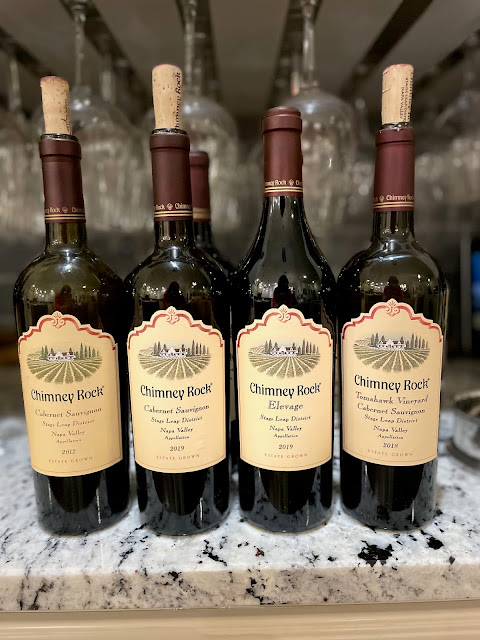Chimney Rock is located in the Stags Leap District of Napa Valley. It was originally established in 1980 by Hack and Stella Wilson on the site of a 185 acre golf course. Currently, the winery focuses on intelligent and sustainable grape farming combined with a soft touch in the cellar from winemaker, Elizabeth Vianna. I had the opportunity to taste with Elizabeth Vianna earlier this week at a private event hosted by another Houston wine writer, Jeff Kralik, who writes under the name of The Drunken Cyclist.
Vianna's goal is to allow the unique Stags Leap District soil and the fruit it produces to be showcased in distinctive wines that display a true sense of place. The Stag's Leap AVA is a smaller and cooler appellation within Napa Valley that is known for creating Cabernet Sauvignon wines that combine both power and grace in the glass.The wines come from estate grown grapes which are hand harvested before being vinified in small lots from the forty distinct vineyard blocks located across the 120 acre estate which is now owned by the Terlato family.
Vianna has been at Chimney Rock since 1999 where she began working as a harvest intern. She later became the assistant winemaker in 2002 before being named head winemaker in 2005. Vianna brought a pair of whites, along with two Chimney Rock red wines from each decade starting in the 1980s, and then concluded with the current releases. This was an exceptional opportunity to taste the evolution of the wines from the estate over a more than 30 year time span.
The Wines:
Chimney Rock Elevage Blanc 2020 and 2016 is described as "the white wine for red wine drinkers." It is a Bordeaux-inspired blend utilizing Sauvignon Gris and Sauvignon Blanc which is fermented in equal parts in new French Oak barrels, neutral French Oak barrels, and stainless steel barrels before aging for 6 months before bottling. Dry, full bodied and rich with a stone fruit and citrus character and a lingering lush caramelized finish. Find the 2020 on the winery website for $50 a bottle.
Chimney Rock Stags Leap District 1984 and 1985 are blends that were composed from across the estate to achieve a balance of the finesse and power created by the different terroir elements of the estate. These two vintages were produced under winemaker, Philip Togni, and are primarily composed of Cabernet Sauvignon with some Merlot. Dry, full bodied,
Chimney Rock Stags Leap District 1992 and 1998 Doug Fletcher oversaw the creation of these two wines. He is known for his "balanced vine viticulture" method of working with nature, he took over as winemaker in 1987. Dry, full bodied
Chimney Rock Stags Leap District 2002 and 2006 These were the first two reds that we tasted that Vianna had overseen, as the assistant in 2002 and then as head winemaker for the 2006 vintage. Dry, full bodied,
Chimney Rock Stags Leap District 2012 and 2019 Dry, full bodied
Chimney Rock Elevage Stags Leap District 2019 is a blend of Merlot, Cabernet Sauvignon, Petite Verdot, and Cabernet Franc which is fermented in stainless steel vats before aging for 18 months in new French oak barrels. Dry, full bodied, with silky tannins and lush dark fruit, and hints of fresh herbs.
Chimney Rock Tomahawk Vineyard Cabernet Sauvignon Stags Leap District 2018 is sourced from a cooler site on the southernmost point of the estate which features multiple soil types. It is fermented primarily in stainless steel vats (with 10% fermented in new French oak) before aging for 18 months in new French oak barrels. This 100% Cabernet Sauvignon wine was the most aromatic with classic dark fruit, cassis, and chocolate notes along with hints of mint, dry and full bodied with a savory edge and a rich, lengthy finish. This was the most powerful of all the reds tasted.
Not all of these wines are available on the website but they are all highly recommended should they be found on a wine list or in a wine shop. Age worthy yet with a suppleness that makes even the newer vintages a pleasure to drink now.



Comments
Post a Comment
Thank you for reading Wine Life - Houston.